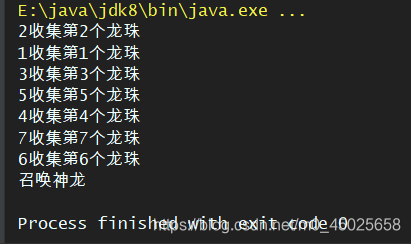狂神JUC——CountDownLatch,CyclicBarrier,Semaphore
本文共 2738 字,大约阅读时间需要 9 分钟。
| JUC | |
|---|---|
| 1 | |
| 2 | |
| 3 | |
| 4 | |
| 5 | |
| 6 | |
| 7 | |
| 8 | |
| 9 | |
| 10 | |
| 11 | |
| 12 | |
| 13 | |
| 14 | |
| 15 | |
| 16 | |
| 17 | |
| 18 | |
| 19 | |
| 20 | |
| 21 | |
| 22 |
1.CountDownLatch
package com.company.common_assist;public class CountDownLatchTest { public static void main(String[] args) throws InterruptedException { //总数是6,必须要执行任务的时候,再使用 java.util.concurrent.CountDownLatch countDownLatch = new java.util.concurrent.CountDownLatch(5); for (int i = 1; i <= 6; i++) { new Thread(()->{ System.out.println(Thread.currentThread().getName() + "go out"); try { countDownLatch.await(); } catch (InterruptedException e) { e.printStackTrace(); } },String.valueOf(i)).start(); } countDownLatch.await(); //等待计数器归零,然后向下执行 System.out.println("Close Door"); }} 运行结果:

2.CyclicBarrier
package com.company.common_assist;import java.util.concurrent.BrokenBarrierException;import java.util.concurrent.CyclicBarrier;//允许一组线程全部等待彼此到达共用的同步复制public class CyclicBarrierTest { public static void main(String[] args) { CyclicBarrier cyclicBarrier = new CyclicBarrier(7,()->{ System.out.println("召唤神龙"); }); for (int i = 1; i <= 7; i++) { final int temp = i; new Thread(()->{ System.out.println(Thread.currentThread().getName() + "收集第" + temp + "个龙珠"); try { cyclicBarrier.await(); //等待 } catch (InterruptedException e) { e.printStackTrace(); } catch (BrokenBarrierException e) { e.printStackTrace(); } },String.valueOf(i)).start(); } }} 运行结果:

3.Semaphore
package com.company.common_assist;import java.util.concurrent.Semaphore;import java.util.concurrent.TimeUnit;//一个计数信号量,在概念上,信号量要维持一组许可证//如果有必要,每个acquire()都会阻塞,直到许可证可用,然后才能使用它//作用:多个共享资源互斥的使用!并发限流,控制最大的线程数public class SemaphoreTest { public static void main(String[] args) { //线程数量:停车位!限流! Semaphore semaphore = new Semaphore(3); for (int i = 1; i <= 6; i++) { new Thread(()->{ try { //如果已经满了,会等待资源被释放 semaphore.acquire(); System.out.println(Thread.currentThread().getName() + "抢到车位"); TimeUnit.SECONDS.sleep(2); System.out.println(Thread.currentThread().getName() + "离开车位"); } catch (InterruptedException e) { e.printStackTrace(); }finally { semaphore.release(); //释放,然后唤醒等待的资源 } },String.valueOf(i)).start(); } }} 运行结果:

转载地址:http://jyhjz.baihongyu.com/
你可能感兴趣的文章
Netty工作笔记0059---Netty私聊实现思路
查看>>
Netty工作笔记0060---Netty心跳机制实例
查看>>
Netty工作笔记0060---Tcp长连接和短连接_Http长连接和短连接_UDP长连接和短连接
查看>>
Netty工作笔记0061---Netty心跳处理器编写
查看>>
Netty工作笔记0063---WebSocket长连接开发2
查看>>
Netty工作笔记0065---WebSocket长连接开发4
查看>>
Netty工作笔记0066---Netty核心模块内容梳理
查看>>
Netty工作笔记0068---Protobuf机制简述
查看>>
Netty工作笔记0070---Protobuf使用案例Codec使用
查看>>
Netty工作笔记0071---Protobuf传输多种类型
查看>>
Netty工作笔记0072---Protobuf内容小结
查看>>
Netty工作笔记0073---Neety的出站和入站机制
查看>>
Netty工作笔记0074---handler链调用机制实例1
查看>>
Netty工作笔记0075---handler链调用机制实例1
查看>>
Netty工作笔记0076---handler链调用机制实例3
查看>>
Netty工作笔记0077---handler链调用机制实例4
查看>>
Netty工作笔记0078---Netty其他常用编解码器
查看>>
Netty工作笔记0079---Log4j整合到Netty
查看>>
Netty工作笔记0080---编解码器和处理器链梳理
查看>>
Netty工作笔记0081---编解码器和处理器链梳理
查看>>